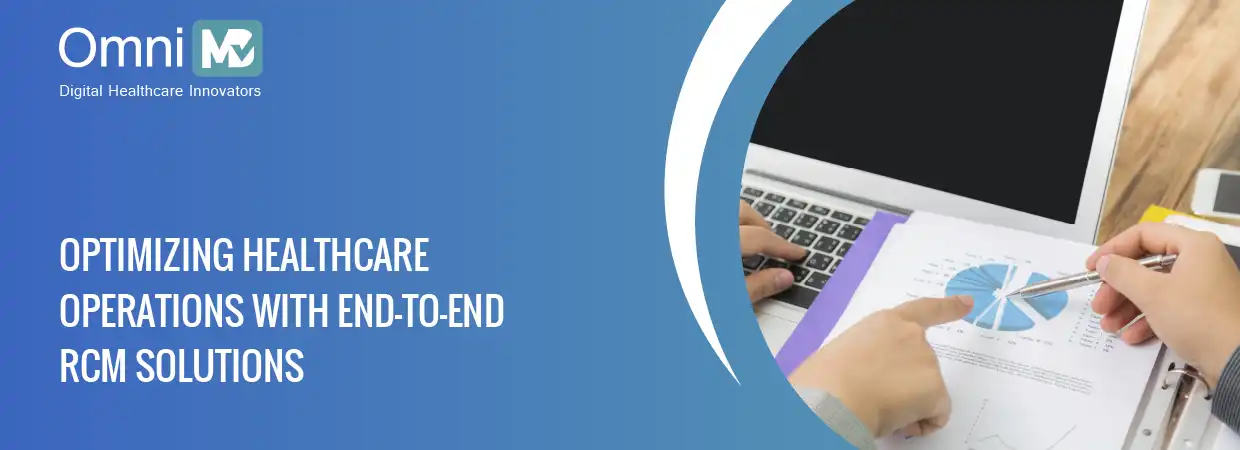Optimizing Healthcare Operations with End-to-End RCM Solutions
Imagine a busy independent healthcare practice, juggling the complexities of medical billing, coding, payer disputes, and staffing shortages—all while trying to stay afloat in an industry facing continuous regulatory changes. Staff are overwhelmed, claims are being rejected due to coding errors or incomplete patient data, and the frustration of lengthy payment cycles is taking a toll on the practice’s cash flow. In this high-pressure environment, the traditional approach of piecemeal billing systems, where different platforms manage patient intake, claims submission, and payment tracking separately, is increasingly proving inadequate.
The good news? There’s a solution that’s gaining traction in healthcare today: end-to-end Revenue Cycle Management Solutions. These comprehensive platforms integrate all stages of the revenue cycle—from scheduling to claims payment—into one cohesive workflow. This approach has the potential to reduce operational friction, ensure faster payments, and ultimately help practices improve their financial stability.
Why End-to-End RCM Is the Right Choice for Providers
Healthcare providers today are under mounting pressure to improve financial outcomes and reduce administrative burdens. According to the American Medical Association (AMA), physician practices are losing billions in revenue due to claim denials, delays, and administrative inefficiencies. And while a robust billing process is essential, it’s no longer enough to simply focus on coding or claim submission. Healthcare organizations must address all aspects of the revenue cycle, including eligibility verification, coding, billing, claims submission, and payments, in a streamlined manner.
This is where end-to-end RCM solutions shine. An integrated platform can eliminate the need for multiple systems and processes, allowing practices to manage every part of the revenue cycle under one roof. When all revenue cycle tasks—such as claims management, coding, payment posting, and collections—are managed together, the healthcare provider can achieve greater efficiency, reduce errors, and ultimately improve profitability.
Challenges That Make End-to-End RCM a Necessity
- Staffing Shortages and Administrative Burdens : Staff shortages in healthcare are a persistent issue. A 2023 report from the American Hospital Association (AHA) found that nearly 100% of hospitals in the U.S. are experiencing some level of staffing shortages, particularly in billing and coding departments. The lack of trained staff can lead to delayed claims submissions, coding errors, and an increased number of claim rejections.
With an end-to-end RCM system, tasks like coding and claim submission are automated and simplified, reducing the burden on overworked staff. A single platform eliminates the need for staff to switch between different systems, minimizing errors caused by redundant data entry and improving overall productivity.
- Razor-Thin Margins and Cash Flow Struggles : Many practices, especially those operating in urgent care, psychiatry, and primary care, are working with razor-thin margins. A single rejected claim can lead to delayed payments, creating cash flow challenges that can have significant repercussions. The National Rural Health Association (NRHA) reported that nearly 30% of rural health clinics experience cash flow issues, with over 50% of their claims being denied at least once.
An end-to-end RCM system addresses this by automating many of the manual tasks involved in claims processing. For example, real-time eligibility verification ensures that insurers cover the patient’s visit, reducing the chances of claims rejection. Additionally, integrated coding ensures that claims are submitted correctly the first time, improving reimbursement rates and reducing delays.
- Payer Complexity and Changing Regulations : The healthcare reimbursement landscape is complex, with payers using different requirements and codes for various services. This complexity is compounded by frequent regulatory changes—like those related to the ICD-10 codes and Medicare billing updates. Keeping up with these changes is not only time-consuming but also expensive if your practice’s systems aren’t integrated.
End-to-end RCM platforms provide automatic updates to reflect the latest payer rules and regulatory changes. This reduces the risk of human error in coding and claims submission, ensuring compliance and maximizing reimbursement.
How EHR-Integrated RCM Systems Provide a Seamless Solution
A powerful way to enhance an end-to-end RCM solution is through integration with Electronic Health Records (EHR). EHR-integrated RCM systems seamlessly combine clinical and financial data, offering several benefits:
- Improved Accuracy and Reduced Errors : By integrating billing functions directly with the EHR, patient information—including demographics, diagnoses, and insurance data—can be transferred automatically into the RCM system. This minimizes manual entry and the associated errors that can lead to claim denials. A study by Zywave found that automated systems cut claim rejection rates by up to 50%, due to reduced data entry errors.
- Faster Claims and Reimbursement : With EHR integration, coding can be done based on the patient’s medical records, ensuring that claims are submitted quickly and accurately. Furthermore, real-time eligibility checks help confirm insurance coverage before the patient even arrives at the practice. This leads to fewer delays in payment and faster reimbursement cycles. According to CAQH, healthcare organizations with automated eligibility verification experience a 20% reduction in claim denials.
- Real-Time Reporting and Analytics : Integrated EHR-RCM systems offer comprehensive reporting capabilities, providing real-time financial insights. Providers can track outstanding claims, monitor payment statuses, and analyze trends across various payers. These insights help practices make data-driven decisions, identify inefficiencies, and optimize their revenue cycle management.
- Simplified Compliance : End-to-end RCM platforms that are integrated with EHR systems are regularly updated to meet changing regulations. This ensures that the practice remains compliant with coding and billing standards, such as the latest updates to ICD-10 codes and payer-specific requirements. Practices can rest assured knowing that their systems are always aligned with the most current regulatory guidelines.
Probable Drawback of an EHR-Integrated RCM
Despite the numerous benefits, there are also potential downsides to integrating RCM with an EHR system:
- Cost of Implementation: The initial investment for an EHR-integrated RCM system can be high, particularly for small practices that are already dealing with financial strain. The cost of software, integration, and training may be a barrier for some organizations.
- Complex Integration Processes: Not all EHR and RCM systems are compatible. Integrating different platforms can be complex and may require technical support. Practices may need to invest in custom integration solutions to ensure that the systems work together efficiently.
- Training and Adoption: While integrated systems reduce the number of platforms staff must use, they still require proper training. Staff members must be able to efficiently navigate both clinical and financial components of the system, which may require time and resources to achieve proficiency.
The Future of RCM: Automation and AI
The global market for RCM services is growing rapidly. According to Grand View Research, the RCM market size is projected to reach USD 306.8 billion by 2023, growing at a CAGR of 11.39% from 2024 to 2030. The future of RCM will increasingly rely on automation and Artificial Intelligence (AI) to further streamline billing and coding processes. AI can be used to predict payer behaviors, identify errors before they occur, and optimize payment cycles.
As RCM systems continue to evolve, their role will become even more critical in improving operational efficiency, reducing administrative costs, and enhancing financial outcomes for healthcare providers.
The Way Forward
End-to-end RCM solutions—especially those integrated with EHR systems—are transforming the way healthcare organizations handle their revenue cycles. From improving billing accuracy to enhancing cash flow, these solutions provide a comprehensive approach to revenue cycle management. However, while the benefits of end-to-end RCM systems are clear, it’s important to recognize potential challenges such as implementation costs and integration complexities. That’s where OmniMD comes in. Our RCM Solutions, powered by advanced technology and backed by years of industry expertise, are designed to help healthcare providers streamline their billing processes, improve cash flow, and reduce the burden of administrative tasks.
At OmniMD, we work with healthcare organizations to implement RCM solutions that are tailored to their specific needs, providing a positive and lasting impact on their operations.
Ready to optimize your revenue cycle and boost your practice’s financial health? Connect with our experts today to learn how our RCM solution can transform your practice’s revenue cycle management.

All-in-One EHR Software
Streamline Your Practice with a Complete EHR Solution

 Written by Neha Singh
Written by Neha Singh
 Reviewed by Shivani Joshi
Reviewed by Shivani Joshi